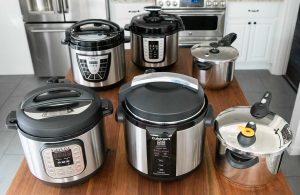Pressure cooking has experienced a renaissance in recent years, with many home cooks rediscovering this efficient cooking method. But questions about its health implications persist. Is pressure cooking genuinely healthier than conventional cooking methods? This comprehensive guide examines the science behind pressure cooking to help you make an informed decision.
Understanding How Pressure Cookers Work
All foods naturally contain water to some degree. The cooking process essentially involves transferring heat through food to initiate numerous molecular changes that result in properly cooked dishes.
The boiling point of water (212°F/100°C at sea level) typically limits cooking speed. This explains why cooking at high altitudes takes longer—lower atmospheric pressure reduces water’s boiling point, causing moisture to evaporate more quickly and potentially drying out food. Simply increasing heat doesn’t solve this problem; extended cooking times are necessary at elevation.
The Pressure Advantage
Pressure cookers fundamentally transform the cooking equation by creating a sealed environment that:
- Increases internal pressure (typically to 15 psi above atmospheric pressure)
- Raises water’s boiling point to approximately 250°F (121°C)
- Dramatically reduces cooking times for virtually all foods
Consider bone broth, which traditionally requires 8-12 hours of simmering. In a pressure cooker, you can achieve comparable or superior results in just 60-120 minutes.
The magic of pressure cooking lies in its ability to maintain optimal moisture levels while cooking at higher temperatures. Unlike conventional high-heat cooking methods that risk burning, drying, or overcooking food, pressure cookers preserve essential moisture through their sealed environment.
Nutritional Preservation: The Evidence
Despite misconceptions that higher temperatures and pressure might destroy nutrients, scientific research suggests the opposite. Multiple studies have demonstrated that pressure cooking actually preserves nutrients better than many traditional cooking methods. Here’s why:
Reduced Cooking Duration Preserves Nutrients
The primary factor in nutrient loss isn’t temperature—it’s cooking time. Extended heat exposure degrades vitamins and phytonutrients. Pressure cooking significantly reduces this exposure, preserving delicate compounds that would otherwise be lost during lengthy conventional cooking.
A 2007 study published in the Journal of Food Science found that pressure-cooked vegetables retained more water-soluble vitamins than those prepared through boiling or steaming.
Minimal Water Contact Maintains Nutritional Value
Pressure cooking requires less water than boiling, functioning more like an efficient steaming method. The sealed environment prevents nutrient-rich steam from escaping, allowing food to cook in its own juices.
Unlike boiling, where water-soluble nutrients leach into cooking liquid that’s often discarded, pressure cooking minimizes this nutrient loss pathway. The limited water used in pressure cooking acts primarily as a means to generate steam rather than as a cooking medium that extracts nutrients.
Enhanced Digestibility of Certain Foods
Pressure cooking offers particular benefits for:
- Legumes: Reduces lectins and phytic acid that can cause digestive discomfort
- Whole grains: Breaks down complex starches for improved absorption
- Tough cuts of meat: Converts collagen to gelatin, enhancing both digestibility and flavor
- Root vegetables: Makes fiber more digestible while preserving nutritional content
Research from the University of Illinois found that pressure-cooked legumes had significantly lower levels of antinutrients compared to conventional cooking methods, potentially improving mineral absorption.
Practical Health Advantages of Pressure Cooking
Beyond the scientific benefits, pressure cooking offers several practical health advantages:
- Time efficiency: Enables busy households to prepare nutritious home-cooked meals in less time
- Energy savings: Uses 50-75% less energy than conventional cooking methods
- Temperature control: Eliminates the formation of potentially harmful compounds associated with high-heat dry cooking methods
- Flavor enhancement: Concentrates flavors, potentially reducing the need for excessive salt or fat
- Batch cooking: Facilitates preparation of healthy meals in advance
Selecting the Right Pressure Cooker
Today’s market offers numerous options, from traditional stovetop models to sophisticated electric multi-cookers. When considering a pressure cooker purchase:
- Research safety features (modern pressure cookers have multiple safety mechanisms)
- Consider capacity based on your household size
- Read consumer reviews focusing on reliability and ease of use
- Determine if programmable functions would benefit your cooking style
- Evaluate warranty coverage and manufacturer support
Many users report that their pressure cookers quickly become essential kitchen tools, particularly for preparing nutritious weeknight meals, batch cooking, and transforming tough cuts of meat into tender, flavorful dishes.
Conclusion: A Healthier Way to Cook
The evidence strongly suggests that pressure cooking represents one of the healthiest cooking methods available to home cooks. By preserving nutrients, improving digestibility, and enabling efficient home cooking, pressure cookers can be valuable allies in maintaining a nutritious diet.
While certain delicate foods may not be suited to pressure cooking, those that benefit from this method will deliver superior nutritional value compared to conventional cooking approaches. The consistent positive findings from both scientific studies and consumer experiences make a compelling case for incorporating pressure cooking into your culinary repertoire.
Whether you’re a health-conscious cook, a busy professional seeking efficiency, or simply someone who appreciates flavorful food, pressure cooking offers compelling advantages worth exploring.

